Soil Fertility
Originally written February 1, 2006 | Last updated
August 21, 2014
Yield Goal v. Yield Potential
Illinois, Iowa, Minnesota, and Wisconsin : estimated productivity of field's
predominant soil type - adjusted using N credits and organic matter
Numerous states: yield-goal approach - 1.2 pounds of N per bushel for corn
following corn, with credits given when corn follows a legume or where manure is
applied
Nebraska and Colorado: expected yield approach - based on expected yield,
the amount of residual soil nitrate-nitrogen, and soil organic matter.
Indiana, Ohio, and Michigan: yield potential and previous crop
Corn yields in the U.S. increased substantially between 1950 and 1970 for several
reasons
- Increased use of fertilizer, particularly N
- Better hybrids
- Improved technology and management
- Earlier planting
- Better equipment
- Higher plant populations, etc
Fertilizer applications should be balanced according to SOIL FERTILITY levels.
Applications are influenced by:
- RECENT CROPPING HISTORY
- Grain Harvest versus Silage Harvest
- SOIL TYPE
- SOIL MOISTURE
- SOIL pH (6.0-7.0 is desirable) pH affects nutrient availability
- Intensive farming gradually lowers soil pH, so soils in many parts of the Midwest
are limed every 4-5 years
- Liming improves soil microbial activity, which
- Increases nutrient availability
- Reduces plant diseases
- Aids in decomposition of crop residues
- Reduces herbicide carryover problems
- Liming also adds Ca and Mg
|
Levels of fertilizer elements (N, P, and K) needed for optimum yields
Corn
- 160-190 lbs available N/a
- Amount of N mineralized from OM in the soil:
- (% OM) (20) = lbs N mineralized/a/yr
- EX: (3.0% OM) (20) = 60 lbs N mineralized/a/yr
- 60-80 lbs P2O5/A
- 280-300 lbs K2O/A
|
Crop Nutrient Removal
|
|
Crop
|
Quantity
|
N
|
P2O5
|
K2O
|
|
Yield
|
N
|
P2O5
|
K2O
|
|
Corn grain
|
100 bu
|
90
|
36
|
26
|
|
150 bu/A
|
135
|
54
|
39
|
|
Corn silage
|
1 ton (~65% moisture)
|
7
|
24
|
7
|
|
20 T/A
|
140
|
48
|
140
|
|
Soybeans
|
100 bu
|
355
|
82
|
100
|
|
50 bu/A
|
178
|
41
|
50
|
|
Wheat
|
100 bu
|
125
|
53
|
31
|
|
70 bu/A
|
88
|
37
|
22
|
|
Alfalfa
|
1 ton (dry hay)
|
50
|
11
|
45
|
|
5 T/A
|
250
|
55
|
225
|
adapted from "The Fertilizer Handbook", The Fertilizer Institute, 1982
derived from Hoeft et al., 2000
|
Soil Testing
Soil tests: Field sampling of soil (5 acres/composite sample)
Tissue tests: Measures N, P and K in cell sap
Apply MANURES: Manure is often spread at a rate of 5-10 tons/a
Commercial Fertilizers
Nitrogen
Forms of N fertilizer
- GAS
- LIQUID
- SOLID (Granular)
- SUSPENSIONS
GAS - Anhydrous Ammonia (82+% N)
Advantages
- High analysis of N (82%)
- Doesn't leach (NH3 form)
- Traditionally the least expensive type
Disadvantages
- Difficult to apply
- Must be knifed 6-8" into the soil
- Soil conditions should be ideal
- Shouldn't work the soil for 5-7 days after applying anhydrous
- Anhydrous requires expensive equipment
- It is stored under pressure as a LIQUID and VAPORIZES when pressure is released,
so it is a GAS when it is deposited in the soil
- Anhydrous is dangerous. Can burn skin critically and cause blindness. When applying,
a person should wear goggles and gloves and cover all skin
- Do not apply on SANDY soil
LIQUID N - Nitrogen solution (28-0-0 or 10-34-0)
Not as dangerous as anhydrous
Is incorporated, either as preplant or as starter, but not incorporated as deep
as anhydrous
Is expensive, so use in Wisconsin has been somewhat localized
Useful in reduced tillage systems, as liquid starter can be placed closer to the
seed than granular - important when planting early in heavy, cold soil
DRY (Granular)
AMMONIUM NITRATE (NH4NO3) 33% N
- NO3 form leaches readily
- Easy to handle, but difficult to store because it absorbs moisture and hardens
- Requires considerable energy to produce, is expensive, and has dropped in popularity
in the 1980's
UREA CO(NH2)2 46% N
- N is in the ammonia form, so it doesn't leach as readily as ammonium nitrate, but
can VOLATILIZE (should incorporate or be rained in within 1-2 days)
- Is blended with other grades of fertilizer
- Many areas have switched from ammonium nitrate to urea
- Urea has a higher analysis of N
- Urea is not as dusty
- Urea is easier to store-doesn't absorb much moisture
Dry fertilizer at Coop's
- Sold in bag or bulk form
- Broadcast and incorporated or banded at planting
- Most coop's keep four grades of dry fertilizer on hand
- UREA: 46-0-0
- POTASH: 0-0-60
- Triple Super Phosphate (TSP): 0-46-0
- Diammonium Phosphate (DAP): 18-46-0
- These are mixed in various formulations eg. 9-23-30 is made by mixing equal amounts
of 18-46-0 and 0-0-60
SUSPENSIONS
Combinations of liquid and granular
A certain amount of solid (undissolved) material is suspended in a liquid medium
Advantages
- Suspensions can hold a higher analysis of N, P, and K than liquid fertilizer
- (Liquid fertilizer can salt out fairly easily)
- Almost any level of micronutrients can be added to suspensions
TIME TO APPLY N
- FALL PLOWDOWN
- SPRING PRE-PLANT
- STARTER
- SIDEDRESSING OR TOPDRESSING
Fall plowdown
- Traditionally, many CORN BELT farmers who apply large amounts of N for corn (150-200
lbs/a) apply ½ to 2/3 of it in the fall
- N should be in the NH3 form, so anhydrous or granular forms are used
- Best to apply when soil temp at 2-4" depth is 50 F or cooler
- NH3 will not convert to nitrate until the soil warms above 50 F the following year
- NITRIFICATION INHIBITORS used if soils have high N loss potential
- SANDY SOILS: Fall application of N should be avoided
Advantages of fall application
- Availability of equipment is usually good
- Avoids ‘spring rush', which can delay planting if the following spring is wet
- Anhydrous may be cheaper in the fall
Disadvantages
- Some N may be lost (Groundwater)
- Although anhydrous may be cheaper, paying 6 months interest can make it more expensive
Spring pre-plant incorporated
- As anhydrous, liquid, granular, or suspension
- In Wisconsin, most fertilizer is applied at this time. Normally there is plenty
of time between thawing and 50o soil temp's. This may not be true in areas of the
corn belt that warm more rapidly in the spring.
Starter
- Usually little response to starter fertilizer in Wisconsin, even in fertile soils
- exception is full season hybrids planted late
- most WI fields have had high manure rates
- Growers who use starter usually apply 150 to 300 lbs/a
- Placement near SEMINAL root system is necessary because plants may have difficulty
absorbing nutrients from the soil early in the season
- Seminal root system is small
- Soil and air temp's usually are cool
- Soil may be too moist for rapid root growth
- Not as popular in areas of the corn belt that warm more rapidly in the spring and
where farms are larger in size
EFFECT OF STARTER FERTILIZER in tillage systems
Usually have a better response to starter fertilizer as the number of tillage operations
is reduced
- Especially true in heavy soils
- May not be true in lighter soils
Response to starter fertilizer usually decreases as fertility level increases
Sidedressing or topdressing
- Sidedressing of anhydrous is usually done 2-4 weeks after emergence
- Sidedressing was decreasing in the Midwest until the mid-1980's. When interest rates
are high and farmers use lower rates of N to be more cost efficient, sidedressing
increases in popularity
FACTORS AFFECTING TIME OF N APPLICATION
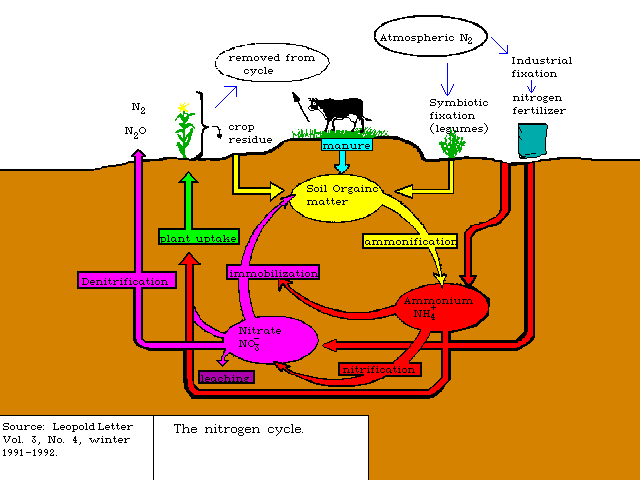
|
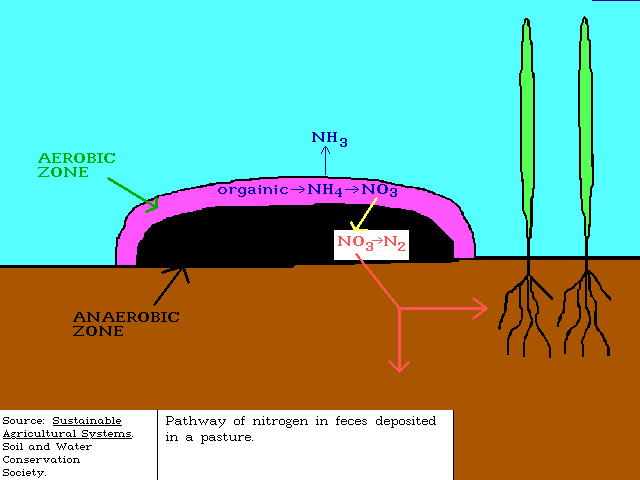
|
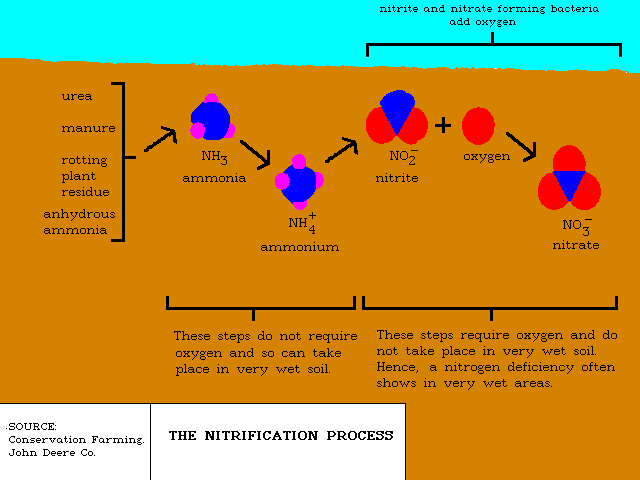
|
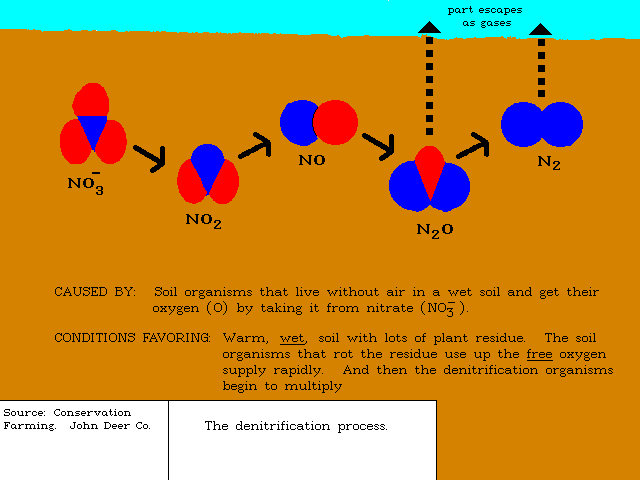
|
|
N-cycle
|
Ammonification
and Nitrification
|
Nitrification
|
Denitrification
|
Form of N
- NH3 - many possibilities
- NO3 - during or after planting
- Soil type
- Heavy versus light
- Soil type and soil temp are closely associated
- Heavier soils warm more slowly, so conversion to NO3 occurs more slowly
Amount of N applied
- If applying low rates of N, time of application can have a substantial effect on
yield response.
- If applying high rates of N, time of application usually does not influence yield
response
Soil fertility level
- Soils that are low to medium in fertility may have a significant yield response
when starter and/or sidedressing are used
Nitrification
Inhibitors - make timing of N application less critical
- Nitrification inhibitors reduce N losses because nitrification (conversion of NH3
to NO3) is delayed
- Activity of Nitrosomonas bacteria is suppressed
- Most often used with anhydrous, but can also be used with liquid or solid forms
of N
- Most often used with fall-applied anhydrous
- Results with nitrification inhibitors have been somewhat inconsistent
- Usually more effective in wet years than in dry years
- Response has been consistent when used on irrigated sandy soils
Slow release compounds
- Supposed to improve N efficiency by reducing losses from LEACHING and DENITRIFICATION
Denitrification
- Loss of oxygen and conversion to N2 gas
- Occurs in water-logged soils; can lose 10 lbs N/a/day
PHOSPHORUS
Is extremely immobile in the soil
Frequently bound up and unavailable
Mineralization is slow: Only 10-20% of the P2O5 applied is used by plants in the
year of application
Virtually all starter fertilizer that is applied to corn has some in it
Purpling of plants
Corn grown in wet, heavy soils that test high in P may have temporary P deficiency
symptoms until soils warm enough for some mineralization to occur. Symptoms usually
disappear by early June.
POTASSIUM
Soils vary in their ability to supply K depending on area of origin and rainfall
Prairie soils - tend to be high in K
Forest soils - tend to be low in K
Normally applied as KCL (= muriate of potash or potash) and K2SO4
Nutrient Management
Soil and Water Management and Conservation
Don't apply nitrogen to soybeans. Well nodualted soybeans will fix all the nitrogen
they require. It is better to inoculate the seed with Rhizobium bacteria
than to apply nitrogen fertilizer.
Nutrient Requirements and Uptake by Plants
Soybean plants (as well as the symbiotic bacteria associated with them) require
all of the following nutrient elements:
- nitrogen (N),
- phosphorus (P),
- potassium (K),
- sulfur (S),
- calcium (Ca),
- magnesium (Mg),
- iron (Fe),
- boron (B),
- manganese (Mn),
- zinc (Zn),
- copper (Cu), and
- molybdenum (Mo).
Most nutrients are absorbed from the soil; however part of the N is obtained from
bacterial fixation in the nodules and some S is absorbed (primarily as SO2 and H2S)
from the air. Soil nutrients are absorbed into the plant roots with water and move
up into the plant to the leaves and other vegetative plant parts.
The amounts of nutrients available vary with
- soil type,
- soil test,
- depth of soil, and
- tillage practices.
They are influenced by soil temperature and moisture conditions.
Roots will not grow into dry soil and moisture must be present for roots to absorb
nutrients from the soil. However excess moisture in the soil limits aeration, and
roots also require air (oxygen).
The amounts of nutrients taken up by the plants early in the season are relatively
small because the plants are small. However the nutrient concentration in individual
leaves of well nourished plants are as high during this period as individual leaves
later in the season. Uptake and accumulation of some nutrients in the leaves continues
throughout the season until maturity; uptake of others is completed by stage.
Redistribution of mineral nutrients from older plant parts to newer growing parts
is a primary source for some nutrients. Some nutrient elements are very
mobile in the plants and are readily translocated from older to newer plant parts.
Redistribution of N, P, and S is a primary source of these nutrients for
growth of the beans and results in severe depletion of these elements in the leaves,
petioles, stems, and pods during the late seed-filling period. However, some nutrients
such as calcium are very immobile in the plants and there is little redistribution
of these elements from older to new plant parts. Late season redistribution of mobile
materials that have accumulated in leaves and other plant parts without redistribution
of Ca results in increased Ca concentration in the leaves late in the season.
Redistribution of other elements in the plant generally is intermediate between
the extremes for very mobile N and immobile Ca. P and S are very similar to N. K
is redistributed from the vegetative plant parts to the developing seeds, but is
not redistributed from the pods. Zn and Cu are redistributed but not to the same
degree as N. Mn, Mg, Fe, B, and Mo are relatively immobile but not as immobile as
Ca. Very marked differences in mobility of Fe have been observed among different
soybean varieties.
Fertilizer Use and Fertility Management
When the soil cannot supply the plant nutrient requirements, fertilizers and/or
manure can be added to supplement the nutrient supply. Uptake of nutrients added
to soils is not always an efficient process. Under good conditions, the recovery
in the year of application ranges from 5 to 20 percent for phosphorus and 30 to
60 percent for potassium. However, additional nutrients are recovered in future
years.
Nutrients Most Commonly Deficient:
- Nitrogen is fixed and made available to the plants by the bacteria in the
nodules on the roots. Where soybeans have not been grown previously, inoculation
is needed to supply the desired bacteria. Liming of acidic soils is usually beneficial.
By making conditions favorable for N-fixation, the need for N fertilization is reduced
or eliminated.
- The availability of phosphorus and potassium in many soils is not adequate
for optimum yields so fertilizers and/or manure to supply these nutrients should
be applied where needed. Depending on soil pH, lime also may be needed.
- Applications of some of the other nutrients are desirable on some soils where deficiencies
exist. S, Fe, B, Mn, or Zn are the elements that are occasionally deficient.
Foliar fertilization micronutrients: Mo, Fe, Cu, B, Zn, Cl, Mn
Foliar fertilization may be effective, particularly if the soil is low in availability
of one or more micronutrients
Effectiveness usually depends on soil pH. Soil pH has a major effect on availability
of micronutrients reduced examples: available availability iron (fe) &
below ph 6.5 above 7.0 other micronutrients molybdenum (mo) above 7.0 below 6.0.
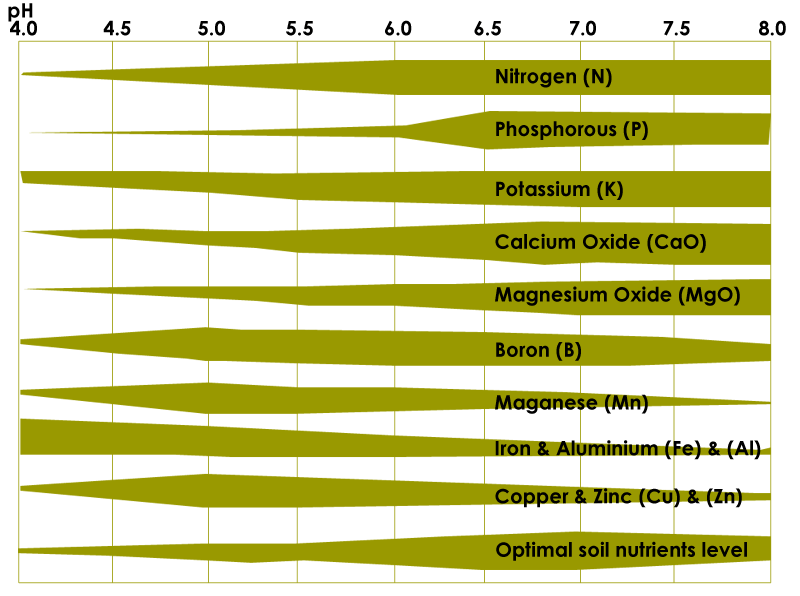
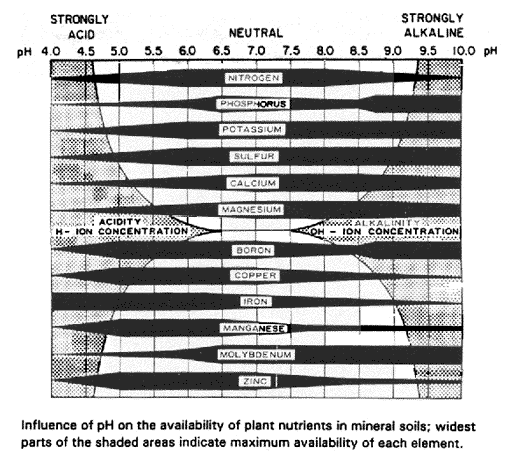
Iron chlorosis (deficiency)
- widespread in prairie soils of midwest (Iowa, Illinois, Minnesota)
- frequent in high lime (calcareous) soils, particularly in cool, wet weather and
poorly drained soils
- infected plants are light green to yellow in color
- plants may recover later in the season, but yields will be reduced
- best control is resistant varieties
- foliar application of sequestrene (iron chelate) is usually helpful
Molybdenum
- the micronutrient that is required in the smallest amounts for plant growth
- more likely to get a response if ph is < 6 because mo is tied up (unavailable)
in acid soils. It differs from the other essential micronutrients in this respect.
- Symptoms are light green leaves
- usually applied foliarly when a deficiency occurs
- molybdenum is difficult to apply with granular fertilizer because it is required
in such small amounts that uniform distribution is difficult.
Further Reading
To purchase hard copies of these publications, go to
The UWEX Learning Store
Management of Wisconsin Soils UWEX Bulletin
A3588
Wisconsin's Pre-Sidedress Soil Nitrate Test UWEX
Bulletin A3630
Corn Fertilization UWEX Bulletin A3340
Optimum Soil Test Levels for Wisconsin UWEX Bulletin
A3030
Sampling Soils for Testing UWEX Bulletin A2100
Aglime--Key to Increased Yield and Profits UWEX Bulletin
A2240
Credit Legume Nitrogen and Reap the Profits UWEX
Bulletin A3591
Credit Nitrogen on Corn and Reap the Profits
UWEX Bulletin A3589
Credit What You Spread and Reap the Profits UWEX
Bulletin A3580
Guidelines for Applying Manure to Crops
and Pastures
UWEX
Bulletin A3392
Choosing Between Liming Materials UWEX Bulletin A3671
Nitrogen Management on Sandy Soils UWEX Bulletin A3634
Soil Calcium to Magnesium Ratios--Should You be Concerned?
UWEX Bulletin A2986
Soil and Applied Boron UWEX Bulletin A2522
Soil and Applied Calcium UWEX Bulletin A2523
Soil and Applied Chlorine UWEX Bulletin A3556
Soil and Applied Copper UWEX Bulletin A2527
Soil and Applied Iron UWEX Bulletin A3554
Soil and Applied Magnesium UWEX Bulletin A2524
Soil and Applied Manganese UWEX Bulletin A2526
Soil and Applied Molybdenum UWEX Bulletin A3555
Soil and Applied Nitrogen UWEX Bulletin A2519
Soil and Applied Phosphorus UWEX Bulletin A2520
Soil and Applied Potassium UWEX Bulletin A2521
Soil and Applied Sulfur UWEX Bulletin A2525
Soil and Applied Zinc UWEX Bulletin A2528
Using Industrial Wood Ash as a Soil Amendment UWEX
Bulletin A3635
When and How to Apply Aglime UWEX Bulletin A2458
Estimating residue using the line-transect method
UWEX Bulletin A3533
Wisconsin Integrated Crop Management Manual: Intro
| Alfalfa |
Corn | Soybean |
Wheat | Nutrients
| Weeds
Know How Much You Haul (Manure)
Management Options for Farms with High Soil Test P
Nitrogen Guidelines for Corn In Wisconsin
Nutrient Management Fast Facts
Nutrient Management Practices for Corn Production
UWEX Bulletin A3557
Phosphorus Cycle - Poster
Soil Testing Basics
Using Legumes as a Nitrogen Source UWEX Bulletin
A3517
What is a Farm Nutrient Management Plan?
When and Where to Apply Manure
Wisconsin's Preplant Soil Nitrate Test UWEX
Bulletin A3512
Wisconsin's Pre-sidedress Soil Nitrate Test (PSNT)
Non-Conventional Soil Ammendments (NCR-103)